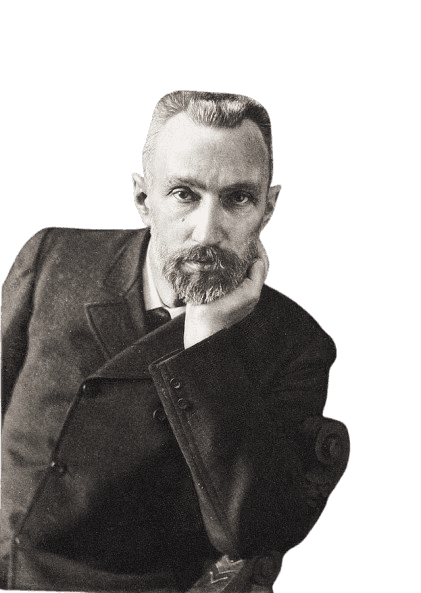Life and achievements
Early life
Pierre Curie was born on May 15, 1859, in Paris, France, to a family with a tradition of being involved in science. His father, Eugène Curie, was a doctor, while his mother, Sophie-Claire Curie, hailed from a family of scholars. Pierre was a home-schooled child, and he displayed a great aptitude for mathematics and geometry even during his childhood.
Before he turned 16, he completed his Bachelor of Science in Mathematics. Pierre did not continue his education to a doctorate level due to financial problems. However, he got a job as a laboratory assistant at the Sorbonne University, where he could continue his research.
At this time, he also became interested in crystallography and magnetism, two areas in which he was to become involved. In 1880, Pierre and his brother Paul-Jacques established piezoelectricity, a physical property of crystals that produces electric charge when subjected to pressure. This discovery was significant in the advancement of different technologies, such as quartz watches and ultrasound.
The work of the Curie brothers in piezoelectricity also culminated in the development of the piezoelectric quartz electrometer, a sensitive instrument that the Curie brothers used in their radioactivity research. As for Pierre, he had the early research that would lead to other collaborations and findings that he would have later on.
In 1891, he was appointed head of the laboratory at the School of Physics and Industrial Chemistry in Paris and continued his research on magnetism. His doctoral thesis, presented in 1895, dealt with the magnetic properties of substances at various temperatures, which resulted in the establishment of Curie's Law and the identification of the Curie point.
Legacy
Pierre Curie was a great scientist who contributed immensely to the field of science. He discovered piezoelectricity, and his work paved the way for many technologies that use piezoelectric materials. Curie's contribution to the field of magnetism, especially Curie's Law and Curie's temperature, is still a reference in the analysis of magnetic characteristics.
His most significant achievement is the work on radioactivity that he carried out with his wife, Marie Curie. Their discovery of polonium and radium not only enriched knowledge about the radioactive elements but also opened the way to radiation therapy in cancer treatment. The Curies' careful study and passion for revealing the characteristics of radioactive substances paved the way for new approaches to scientific investigation.
Pierre Curie's influence did not end with his death because his family took over from where he left off. His wife, Marie Curie, continued the research and was awarded another Nobel Prize in Chemistry in 1911. Their daughter, Irène Joliot-Curie, also got the Nobel Prize in Chemistry in 1935 for her research in artificial radioactivity, thus following in her parents' footsteps.
Even though he died young, Pierre Curie's scientific contributions were immense. Many contemporary technologies and scientific discoveries owe their origin to his work, and his contributions remain relevant to this day. With its significant accomplishments, the Curie family is a legacy of Pierre Curie's impact on physics and other spheres of life.
Milestone moments
Jul 19, 1895
Marriage to Marie Skłodowska
Pierre Curie married Marie Skłodowska on July 26, 1895, thus starting one of the most famous scientific unions.
Marie and Pierre married the previous year after Marie's co-worker introduced them when she was searching for a laboratory to conduct her research.
They had a happy marriage, and they shared an interest in science and its discoveries, especially radioactivity.
They both managed to work as scientists while also being parents to two daughters, Irène and Ève, who also became scientists and writers.
Mar 19, 1903
Nobel Prize in Physics
In March 1903, Pierre Curie, Marie Curie, and Henri Becquerel were awarded the Nobel Prize in Physics for their work in the field of radiation.
The Curies' discovery of polonium and radium and their research on radioactivity brought fame to the family and changed the course of physics.
The Nobel Prize paid tribute to the great work done by the Curies in discovering radioactive substances and their characteristics.
This achievement is the starting point of the Curie family's Nobel Prize legacy, and the subsequent generations have also contributed to scientific discoveries.
Dec 19, 1904
Being appointed as a Professor at the Sorbonne.
Pierre Curie joined the faculty of Sorbonne, the most famous university in France, as a professor in December 1904.
This appointment acknowledged the great that Curie had done for science, especially in crystallography, magnetism, and radioactivity.
Curie remained a professor, expanded research and need, and taught students such as Paul Langevin and André-Louis Debierne.
His lectures and research at Sorbonne helped enhance his status as one of the most prominent physicists of the age.
Apr 19, 1906
Tragic Death
Pierre Curie died in a street accident in Paris on April 19, 1906, which put an end to the life of a great scientist.
Curie fell and was run over by a horse-drawn carriage, an unfortunate and rather gruesome end for a man of his caliber.
His passing was a significant blow to the scientific fraternity and to his family, especially his wife Marie, who carried on with their research even after the loss of her husband.
Curie died young, and many issues remained unresolved; however, Marie Curie and her offspring continued his work.
